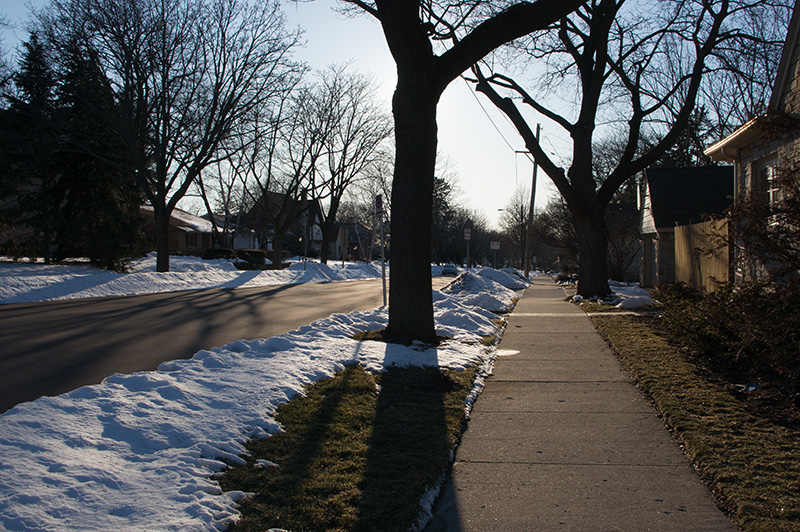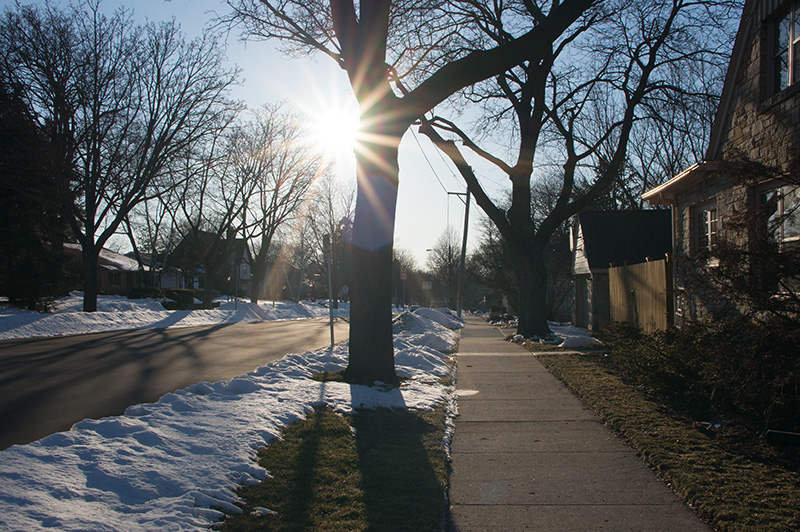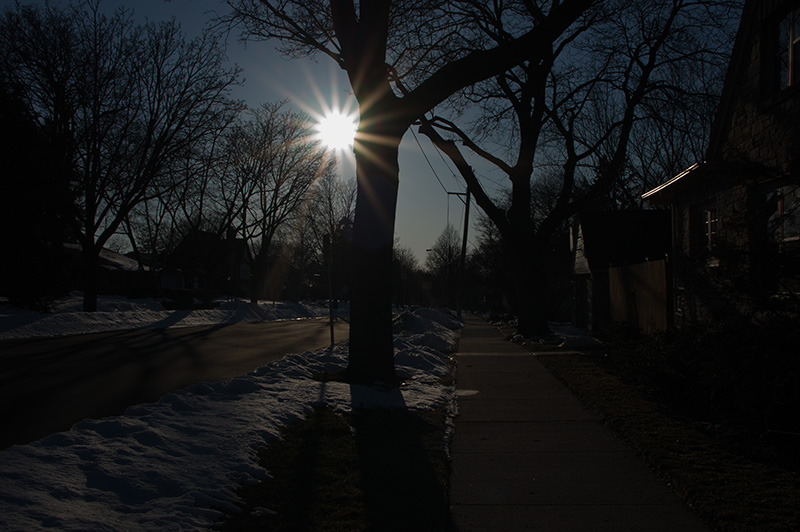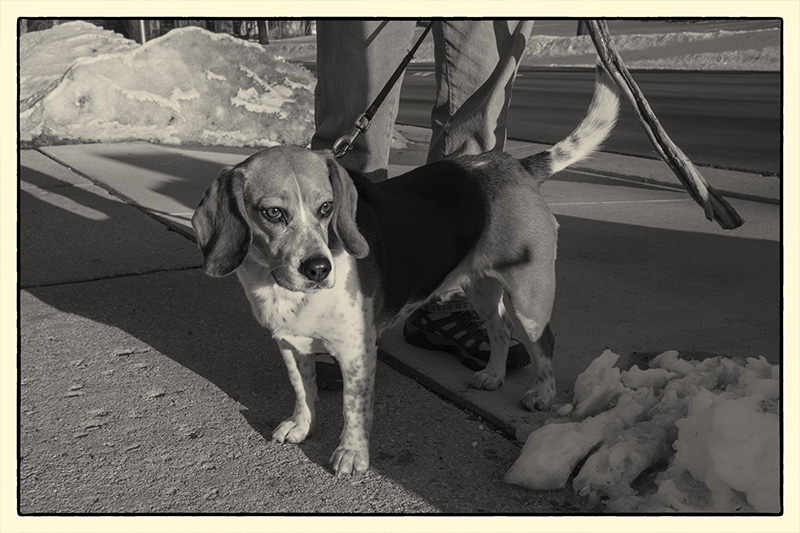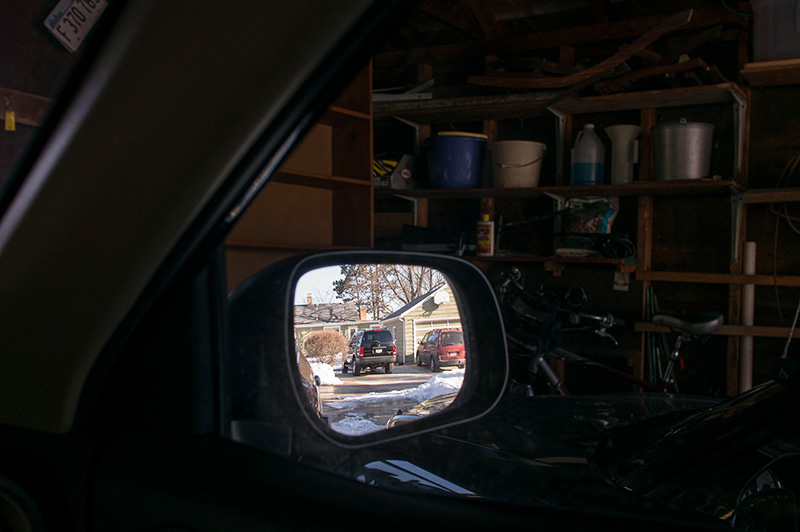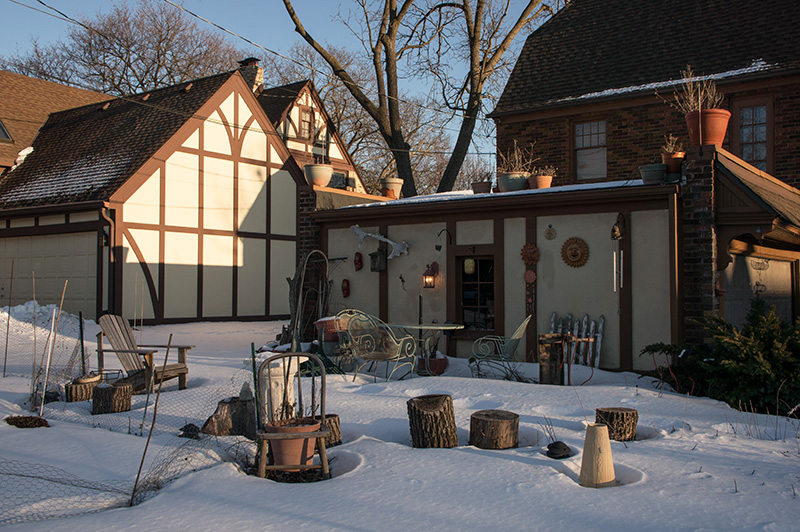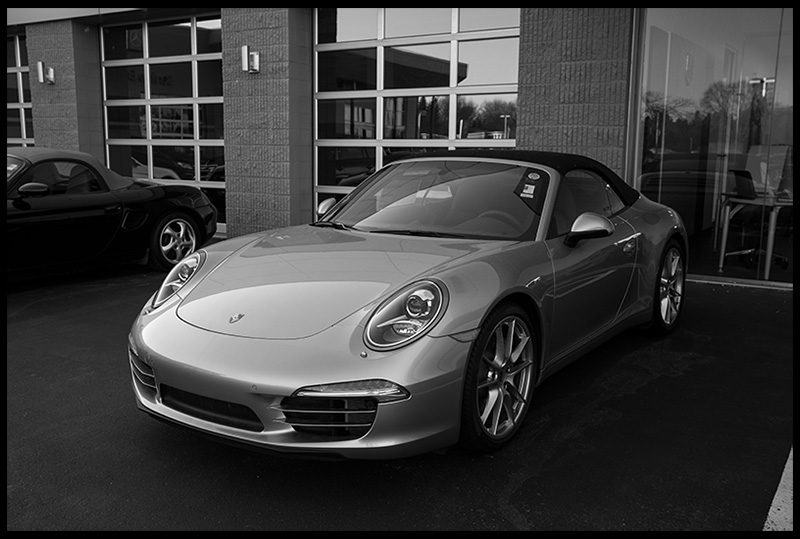 Sony NEX-6, Zeiss ZA Sonnar E 24mm ƒ/1.8
Sony NEX-6, Zeiss ZA Sonnar E 24mm ƒ/1.8
To begin with, apropos of nothing, here's Daisy. She belongs to a neighbor I encounter occasionally on walks around the neighborhood.
At the close of our chat (with the neighbor, I mean, not the dog), I turned around and saw I was near the shadow of a tree.
Now, when I try out lenses, I have a whole range of semi-standard "information-gathering" shots I take. Just to put the lens through its paces and see how it does. These don't rise to the level of "tests," really; I just want to see. I've been doing this for a long time now, and I can deconstruct a lens's basic performance pretty rapidly without trying too hard.
Then, when I see an area of weakness or strength, I do some more shooting to "provoke" those qualities, to further suss out what's going on. It's not rocket science.
I need to digress and mention that these days, you aren't testing just a lens when you try it out this way. You're testing a lens/sensor combination. There are ways to evaluate lenses without connecting them to sensors, but I'm not sure why you would; what you want to know is how the lens performs on a camera, not how it performs without a camera attached (i.e., on the optical bench). I mean, the latter might be interesting, in a detached sort of way, and it might be good for future reference, but it's not terribly practical. What you want to know is how the sensor performs with the lens and the lens with the sensor.
So, anyway, one trial I do is to put the sun behind a tree trunk and make a series of shots with more and more of the sun in the frame. It gives me a quick read on the rendering of ghosts and veiling glare (both are types of flare), and...damn, I can't remember the word for it—the "rays" that appear to come from a bright light source. [UPDATE: Sun stars. Thanks, Dave. —Ed.]
Then I'll do a few shots with the full sun up in the corner of the frame, because with some lenses that provokes ghosts more readily. (Ghosts are the localized anomalies created on the image by flare. These are ghosts.)
So anyway, yesterday I shot this:
Then a series of three more shots moving slightly to my left, each one showing a bit more sun peeking out from behind the tree trunk, the last of which had the sun fully visible and not obscured by the tree at all:
Here's the same file as in figure 2, but with the exposure cranked down so you can clearly see the exact position of the sun:
Now, if you look at those two shots, figure 1 and figure 2, you can clearly see the effect of flare: there's a distinct 14-point starburst, a distinct ghost (close to the sun at about 5 o'clock), and, if you'll let your eyes go back and forth from one frame to the other in the areas away from the sun, you'll distinctly see the effects of veiling glare (the overall, contrast-reducing type of flare).
SNAFU!
Then I though, "Oh, crap, I screwed up." I had left the camera on Program Mode as I made the four successive flare trial exposures.
Obviously, when you're doing a test like this, you don't want the exposure changing as you go from frame to frame. You want any visual differences to be the effect of flare, not exposure change. So I changed the camera to Manual Mode, set the exposure based on the blue sky away from the sun, and repeated the four exposures.
It wasn't until I got back to the computer that I discovered something very strange. Take a look at figures 1 and 2 again. Both of those exposures were made on Program Mode. Figure 1 is ƒ/11 at 1/160th and figure 2 is ƒ/11 at 1/200th.
Huh? Left to its own devices, the camera only adjusted a third of a stop between the exposure with the sun hidden behind the tree and the sun in full view? Normally that will change the AE reading pretty radically.
Then I noticed something else. In my second series, I deliberately metered the open blue sky looking East, that is, opposite the sun...and came up with ƒ/8 at 1/32oth. Exactly the same exposure as the camera set for itself in figure 1!
So I learned a little bit about flare, yes. But I also inadvertently got thumped on the noggin with a clue about how the camera meters and exposes.
So then I went over all the rest of my exposures from that walk. Granted, the sun was low in the sky, but we're under an intense high pressure system and the sunlight was still very bright. And sure enough, in frame after frame, left to its own devices on Program Mode with Auto ISO, I notice two very definite tendencies:
- The camera seems to be exceptionally good at holding highlights; and
- It seems to be exceptionally good at nailing the proper exposure, even with predominantly bright image-objects (e.g., mounds of snow) or predominantly darker image-objects (e.g., spruce trees) dominating the frame.
That's just preliminary. Right now, with the sun high in the sky and the high pressure system still in full force, I'm heading out to deliberately torture the NEX-6 a bit and see how well those assumptions hold up.
Coda
Before I close for now, here's the last trial shot, with the full sun up in the corner of the frame:
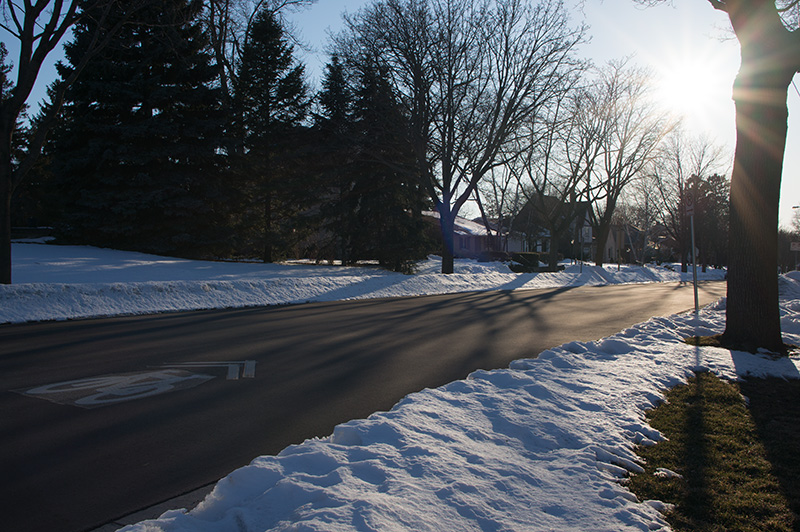 Fig. 4. The sun in the corner of the frame
Fig. 4. The sun in the corner of the frame
There's really only one faint ghost, just where the branches start on the bare tree near the middle of the frame. And it's not extreme.
Tentative conclusion: flare performance is only so-so by today's standards, meaning good by historical standards, but, on the other hand, the lens/sensor is pretty good at resisting ghosting with the sun in the corner of the frame. Good to know.
And here's friendly Daisy suffering the fortunately harmless effects of late-night experimentation with Nik Silver Efex Pro 2...an old-fashioned-y 1950s-ish Verichrome-Pan sort of vibe. Good doggie!
Mike
UPDATE, 9 p.m.: Well, I went out this afternoon with the best of intentions, but, as often happens, I got interested in photographing and forgot what I was supposed to be testing. I specifically meant to do some demo shots for CA, for instance, and I neglected to.
I think a confident verdict on my "two tendencies" listed above will have to await lots more accumulated shooting. But most of the "torture testing" I did today supported rather than contradicted the conclusion that the NEX-6 is particularly good at getting the exposure right and especially at protecting the highlights (the latter long a bugbear of mine with digital).
This shot, for example, naturally needed a bit of correction, but the exposure the camera chose by itself was, surprisingly, just about what I would have picked.
Maintaining usable detail in both the highlights and the shadows at the same time is the perennial challenge of outdoor natural light photography. This shot from yesterday, with a largish area of brightness away from the center of the frame, is an example of one of the kinds of pictures camera metering systems tend to have a hard time with, which is why it's so necessary to keep an eye on them. Here the tonality is quite good throughout the frame; the tan sunlit wall (which was visually far brighter than it looks here) has clipped just a bit, but only in the red channel. Our eyes get sensitive to the look of clipping, and a seasoned digital photographer might look at that area of the file with a touch of suspicion, but a civilian would never notice.
The detail in this shot is nice. It wouldn't surprise me if people lucky enough to own the NEX-7 are also liking the 24mm ƒ/1.8 Sonnar, because I would guess that this lens is even more rewarding with more resolution on tap.
I'm liking the combo's way with B&W quite a bit, too. (This looks a lot better bigger, but oh well.) The combination of lens contrast (not the same thing as contrast) and the camera's way with highlights is a nice one-two combination for B&W.
This idea that the Sony NEX-6 is unusually good at exposure—and with highlights—is something to keep in mind. It might prove to make it an excellent recommendation for the type of photographer who doesn't care to continually tweak (or worry about tweaking!) exposure, but just wants to set the camera on P and go.
Original contents copyright 2013 by Michael C. Johnston and/or the bylined author. All Rights Reserved. Links in this post may be to our affiliates; sales through affiliate links may benefit this site.
(To see all the comments, click on the "Comments" link below.)
Featured Comments from:
John McMillin: "I can confirm what you're saying here. Both my Sonys, an a700 and a850, have shown excellent dynamic range. The highlight recovery capabilties of my a850 are especially good. Sony's DRO feature does the rest of the task, lifting the shadows as well as Lightroom, or better. Every time I try a different camera brand in harsh Western sunlight or high-DR interior shots, I miss that. When I use HDR, it's for an effect, not to extend dynamic range. That's rarely a problem.
"I'm looking hard for an alternative system, because I don't like EVFs and other recent Sony design directions. I just love the results from their sweet sensors. The closest I've come to the Sonys' long, forgiving tonal range was with my Fuji X10, whose EXR sensor does its own magic. Maybe I'll give the Pentax K-5 a try, as its prices fall. Isn't it rumored to pack a Sony sensor...like the OM-D, the first Olympus to garner praise for tonal range?
"Like 'em or not, Sony has some secret sauce. Now if their cameras didn't get in the way between those sensors and the Minolta lens collection, like some lump in the bed."
Andy Kochanowski: "Mike, I can spare you any suspense on this one, though you probably know it by now. For wandering-around photography, the Sony is pretty well perfect. I've been using the NEX-7 with the two Sigma lenses and the 18–55mm kit for the past six months, and sold all my Micro 4/3 stuff, including the GX1 which I also loved, because I wasn't using it at all. Balance, haptics, remarkably good sensor, fast enough AF, fine VF, cheap lenses (except the one you're testing), decent battery life—this thing's da bomb.
"About all that menu carping that the Interweb does: at least on the NEX-7 once you set it up you literally never look at the menu again. Every control you need can be hard-wired. Once I had it for a few days I got why Kirk Tuck's been all over this thing for the past year."
Sarge (partial comment—for the rest of Sarge's comment, please see the Comments section): "My first authoritative reading about flare was William Schneider's TOP article, 'One Photographer's Take on Flare,' which includes a link to Mike's LL article, 'The Filter Flare Factor.' I love sunstars captured without aid of special effects filters mainly because it isn't alien to our experience (as in 'seeing stars'). Likewise, 'sunstars' off a tulip glass or a polished car fender. I've always thought that the number of rays in a sunstar is determined by the number of aperture blades in a lens' diaphragm. How does the 7-blade Sonnar E 24mm ƒ/1.8 produce 14-ray sunstars? (Is it software?)"
Hugh Crawford replies to Sarge: "No, it's not software. Every blade of the aperture produces a 'ray' that crosses the light source. An even number of aperture blades makes rays that overlap, so an eight blade aperture makes 16 rays at intervals of 45 degrees which means that they overlap and you only see eight rays. An odd number of blades make rays that don't overlap, so a nine-blade aperture produces 18 rays, one every 40 degrees.
"Some people seem to like 'sun stars' but I think they are one of the most annoying things about automatic aperture SLRs which is about the only application where they (and the ugly polygons) can't be easily designed out of the lens."
